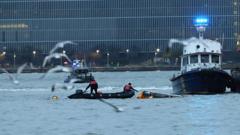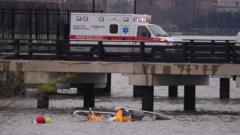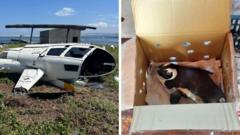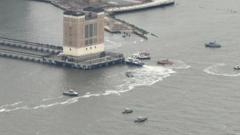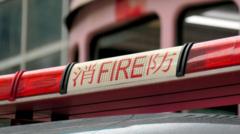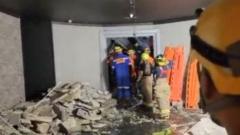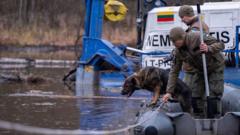The report outlines multiple issues, including miscommunication and changes to operational protocols, that exacerbated the fatal accident.
Faulty Antenna Linked to Tragic Helicopter Crash in Australia
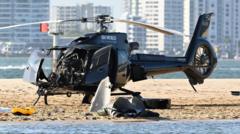
Faulty Antenna Linked to Tragic Helicopter Crash in Australia
A recent investigation reveals a faulty radio antenna contributed to a catastrophic helicopter collision that claimed four lives at a popular Australian theme park.
The Australian Transport Safety Bureau (ATSB) has announced that a faulty radio antenna played a significant role in a catastrophic helicopter crash at Sea World on the Gold Coast back in January 2023. This collision resulted in the deaths of four individuals, including two British tourists, and left several others with serious injuries. The ATSB's investigation indicated that one of the helicopter pilots failed to receive a crucial radio communication shortly before the mid-air collision.
The incident took place just twenty seconds after one helicopter took off while another was attempting to land. Tragically, those who perished were onboard the aircraft that was departing, while the other managed an emergency landing despite the passengers suffering injuries.
The ATSB report emphasized that the changes made by Sea World in recent months, including introducing a new helipad and larger helicopters, compromised previously established safety protocols for traffic management. These modifications created a danger zone where the operations of departing and arriving helicopters conflicted.
According to the investigation, the helicopter preparing for takeoff had a malfunctioning antenna, which hindered the pilot’s reception of an essential landing call from the incoming helicopter. Although a crew member mistakenly assured the pilot that the airspace was clear, this information had quickly become outdated by the time the helicopter took off.
The pilot of the inbound helicopter had visually noted the other helicopter on the ground and did not regard it as a risk. However, without the taxiing communication necessary to alert him of the potential hazard, he remained unaware that the other helicopter was in the process of departing.
Among the victims were Diane Hughes, 57, and her husband Ron, 65, who had recently married and were visiting family. The crash also claimed the life of 36-year-old Vanessa Tadros, a resident of Sydney, and 40-year-old pilot Ashley Jenkinson, originally from Birmingham.
Additionally, six individuals suffered severe injuries, while three experienced minor injuries. Passengers from the helicopter that safely landed described their pilot as a "hero" for averting further disaster.
The ATSB highlighted 28 critical findings intended to provide key lessons for both operators and pilots in the future. Chief Commissioner Angus Mitchell emphasized the importance of managing changes to aviation practices, warning that improvements could lead to unforeseen safety risks. To ensure overall safety is maintained, he urged that any operational adjustments be approached through a structured process.
This tragic incident serves as a stark reminder of the complexities in aviation safety and the unintended consequences of operational modifications.
The incident took place just twenty seconds after one helicopter took off while another was attempting to land. Tragically, those who perished were onboard the aircraft that was departing, while the other managed an emergency landing despite the passengers suffering injuries.
The ATSB report emphasized that the changes made by Sea World in recent months, including introducing a new helipad and larger helicopters, compromised previously established safety protocols for traffic management. These modifications created a danger zone where the operations of departing and arriving helicopters conflicted.
According to the investigation, the helicopter preparing for takeoff had a malfunctioning antenna, which hindered the pilot’s reception of an essential landing call from the incoming helicopter. Although a crew member mistakenly assured the pilot that the airspace was clear, this information had quickly become outdated by the time the helicopter took off.
The pilot of the inbound helicopter had visually noted the other helicopter on the ground and did not regard it as a risk. However, without the taxiing communication necessary to alert him of the potential hazard, he remained unaware that the other helicopter was in the process of departing.
Among the victims were Diane Hughes, 57, and her husband Ron, 65, who had recently married and were visiting family. The crash also claimed the life of 36-year-old Vanessa Tadros, a resident of Sydney, and 40-year-old pilot Ashley Jenkinson, originally from Birmingham.
Additionally, six individuals suffered severe injuries, while three experienced minor injuries. Passengers from the helicopter that safely landed described their pilot as a "hero" for averting further disaster.
The ATSB highlighted 28 critical findings intended to provide key lessons for both operators and pilots in the future. Chief Commissioner Angus Mitchell emphasized the importance of managing changes to aviation practices, warning that improvements could lead to unforeseen safety risks. To ensure overall safety is maintained, he urged that any operational adjustments be approached through a structured process.
This tragic incident serves as a stark reminder of the complexities in aviation safety and the unintended consequences of operational modifications.



